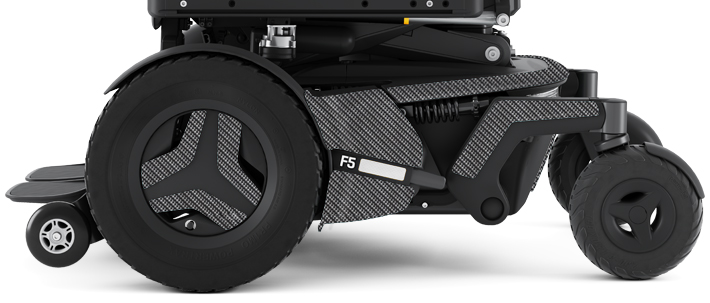The drive wheel on a power wheelchair is the larger wheel if you are looking at your wheelchair or client’s wheelchair. The location of this drive wheel can have a large impact on how the power wheelchair drives and manoeuvres in different environments.
There are three main types of drive wheel configurations on power wheelchairs: front-wheel drive, mid-wheel drive, and rear-wheel drive. In this blog today, we will focus on mid-wheel drive.
Mid-Wheel Drive:
The mid-wheel drive power wheelchair is the most recent technology developed for power wheelchair bases. It attempts to combine the positive aspects of front-wheel and rear-wheel drive into a hybrid product. Mid-wheel drive has many benefits. The most well-known benefits being the small turning radius and intuitive driving. The mid-wheel drive power wheelchair has the smallest 360 ̊ turning radius which can improve manoeuvrability for many individuals in their home or smaller spaces. The intuitive driving benefit is due to the placement of the drive wheel. Typically, in the mid-wheel drive, the client will be sitting directly over the drive wheel, which is where the chair will turn/rotate from. This axis of rotation being directly under the individual is what makes the driving intuitive or often people will say “easier to learn”. It is important to remember that in some cases the mid-wheel drive may not line up directly below the client and therefore may lose some of that intuitive driving. The final benefit to discuss for mid-wheel drive is the stability. Because a mid-wheel drive wheelchair has 6 wheels on the ground, this chair will offer superior stability. This can be the case whether ascending, going up, or descending, going down, ramps or inclines.
While there are many benefits for mid-wheel drive power wheelchairs, there are a couple considerations when deciding if mid-wheel drive is right for you or your client. In being a superior option for stability, the 6 wheels on the ground also means that more energy from the ground is transferred to the client. Imagine going over a bump, because there are 6 wheels you could feel that bump 3 times versus the 2 of the front-wheel drive. This could potentially limit the ride comfort for the individual in the chair. Luckily, depending on each manufacturer, we have suspension to help decrease the impact of having 6 wheels on the ground. I LOVE talking about suspension and we will have a blog post coming soon to talk all about suspension in power wheelchairs and the importance of the suspension. The other comment I hear about mid-wheel drive power wheelchairs is the potential for “high centring”. This term is used to describe when the centre drive wheels lose traction and may not be able to move in certain situations. This is particularly a risk with uneven terrain and was previously the biggest disadvantage of the mid-wheel drive power wheelchair. However, depending on your manufacturer, newer technologies and suspension can compensate and have greatly decreased the risk of this occurring.
The mid-wheel drive power wheelchair is the most popular drive wheel configuration and for good reason. As technology continues to progress, the mid-wheel drive continues to have greater benefits with less limitations.
Keep in mind that not everyone will benefit from the same drive wheel configuration and it is important to ask questions and complete an evaluation to determine which drive wheel would be best for you or your client.

Rachel Fabiniak PT, DPT
Director of Clinical Services
Rachel Fabiniak began her studies at The Georgia Institute of Technology, where she graduated with her Bachelor of Science in Biology in 2009. Rachel then went on to receive her Doctorate in Physical Therapy from Emory University in 2013. After receiving her doctorate, Rachel went into clinical practice as a physiotherapist in the Spinal Cord Injury Day Program at Shepherd Center in Atlanta, Ga. Rachel also has experience in community physiotherapy and inpatient rehabilitation. During Rachel’s time at Shepherd Center, she developed a passion for seating and mobility which ultimately led to her career with Permobil. Rachel joined on with Permobil in January 2018 and relocated to Sydney, Australia in June 2018 as the clinical education specialist for Australia and New Zealand. In February 2020 Rachel moved into the role of Director of Clinical Services for Asia-Pacific.
